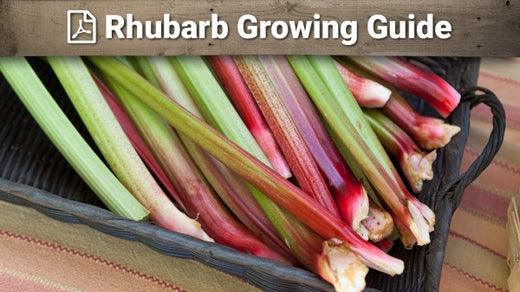Comprehensive Guide to Growing and Caring for Rhubarb
Rhubarb is a robust perennial vegetable known for its tart stalks and versatility in recipes. It thrives in cooler climates and offers years of productive growth when properly cared for. Here’s a detailed guide to planting, nurturing, and enjoying this garden favorite.
Click here to access the complete Rhubarb Growing Guide (PDF) for detailed information on soil preparation, planting, and long-term care.
Soil and Site Preparation
Rhubarb prefers fertile, well-drained soil high in organic matter. Ensure the planting site is free from perennial weeds, as they can hinder rhubarb's growth. Cultivate the soil in spring and after cutting to maintain its condition. For optimal growth, aim for a slightly acidic to neutral pH (6.0–6.8). Adding compost or a balanced fertilizer each spring boosts soil fertility and improves crop quality.
Planting and Spacing
Space rhubarb roots 24–48 inches apart in rows 3–4 feet apart. For smaller gardens, reduce row spacing but avoid overcrowding to prevent disease. Plant roots with the crown bud 2 inches below the soil surface. Firm the soil around the roots but keep it loose over the buds. Raised beds help prevent crown rot in areas with poor drainage.
Care and Maintenance
Water rhubarb regularly to maintain vigorous growth. Remove flower stalks as they appear to direct energy to the plant. Avoid harvesting during the first year to allow roots to establish. Starting in the second year, stalks can be lightly harvested, increasing to full harvesting in subsequent years.
Harvesting Tips
Pull or cut stalks at the soil line and remove leaves, as they are toxic. Harvest selectively over 4–6 weeks to encourage continuous growth. With proper care, rhubarb will remain productive for 8–15 years.
Key Considerations
Rhubarb thrives in climates with winter dormancy (temperatures below 40°F) and moderate summer heat. While it can grow in southern regions, excessive heat may reduce stalk quality and color.
With its resilience and ornamental appeal, rhubarb is a fantastic addition to any garden. Enjoy its unique flavor in pies, sauces, and other culinary delights.
🌿 Additional Resources for Growing and Caring for Rhubarb
Expand your knowledge and improve your rhubarb harvest with these detailed guides and seed collections.
- 🌱 Growing Rhubarb in Raised Beds and Containers
- Learn how to successfully grow rhubarb in raised beds or containers, ideal for small spaces or gardeners with drainage challenges.
- 🌞 Forcing Rhubarb for Early Harvests
- Discover techniques to force rhubarb indoors or in sheltered conditions to enjoy fresh stalks earlier in the season.
- 📖 Rhubarb: Growing Tips and Facts
- A comprehensive article covering rhubarb history, varieties, and practical growing advice to help you master this perennial.
- 🛒 Shop Rhubarb Crowns and Plants
- Find a selection of healthy rhubarb crowns and plants, perfect for starting or expanding your rhubarb patch.

